 01. " Into the wild" : when ecological and sociological perceptions of forest naturalness converge 01. " Into the wild" : when ecological and sociological perceptions of forest naturalness converge
1 Yoan Paillet, Cemagref 2 Pierre Le Quéau, Université Pierre Mendès 3 Benoit Dodelin,
Abstract :
Naturalness is widely used to assess the conservation value of forest ecosystems. As this concept encompasses ecological as well as sociological aspects, we adopted an inter-disciplinary approach to study naturalness in two french forests (one managed and one unmanaged). The aim was to know whether differences between the two forests assessed through measured ecological indicators, including stand characteristics, and public perception converged. We translated scientific language into more easily accessible terms, then interviewed 30 visitors in each forest. Many ecological and sociological perceptions did converge, notably in terms of criteria of composition, structure and function. However, more specifically, some scientific terms could not be fully transposed and some indicators of naturalness diverged between scientists and general public. The general public seems to be able to differentiate between degrees of naturalness, but studies as the one conducted here need also more influence of sociology on ecology to be fully interdisciplinary. Involving the general public in forest conservation issues could enhance understanding and avoid potential conflict. Download poster :  |
02. Developing Natural Analogues for Coarse Woody Materials for Use in Restoration of Boreal Ecosystems1 Tim Vinge, Government of Alberta 2 Matthew Pyper, Alberta School of Forest Science and Management, University of Alberta 3 John R. Spence, Alberta School of Forest Science and Management, University of Alberta
Abstract :
The energy sector in Alberta has been operating on the Boreal landscape for a number of years. Several different features including well sites, pipelines and seismic lines have become commonplace on the boreal landscape. Fires have continued to operate on this boreal landscape as well. Past practices and Government policy have dictated a neat and tidy approach to managing coarse woody materials. Concerns from fire managers have dictated removal of excess woody debris. In response to this, much of the woody debris has been piled and burned or mulched in order to meet the current regulations. At the same time, many other papers have documented the importance of coarse woody materials in forests.
Through this research project we established natural analogues for woody materials based on Natural Subregions in Alberta, Canada. We used forest industry volume sampling data as well as data from the Alberta Bio Monitoring Program to establish background woody debris levels in forests, and these levels were associated with different forest attributes and combinations of forest attributes. The research deliverable is a set of woody debris analogues tied to Natural Subregion. This information will also be used to establish woody debris levels for restoration of sites created by the oil and gas sector. Best management practices will be developed based on these levels and will be used to inform Government policy on managing woody debris in future energy sector programs.
Download poster : available soon |
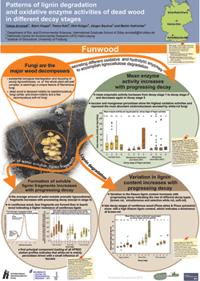 03. Patterns of lignin degradation and oxidative enzyme activities on dead wood as a function of decay stage and fungal colonisation 03. Patterns of lignin degradation and oxidative enzyme activities on dead wood as a function of decay stage and fungal colonisation
1 Tobias Arnstadt, Department of Bio- and Environmental Sciences, International Graduate School of Zittau 2 Björn Hoppe, Helmholtz Centre for Environmental Research (UFZ) Halle-Leipzig 3 Tiemo Kahl, Institute of Silviculture, University of Freiburg, Germany 4 Dirk Krüger, Helmholtz Centre for Environmental Research (UFZ) Halle-Leipzig 5 Jürgen Bauhus, Institute of Silviculture, University of Freiburg 6 Martin Hofrichter, Department of Bio- and Environmental Sciences, International Graduate School of Zittau
Abstract :
Dead wood, also referred to as coarse woody debris (CWD), is decayed by various types of organisms such as insects, bacteria and notably by fungi. Among the latter, chiefly Basidiomycota (white- and brown-rot fungi) and a few Ascomycota (soft-rot fungi) are the main wood decomposers. To accomplish lignocellulose degradation, they actively secrete different sets of oxidative and hydrolytic biocatalysts (peroxidases, laccases, polysaccharide hydrolases). Here, we report on the variability of lignin degradation and the presence of oxidative enzyme activities in dead wood in relation to fungal diversity along a forest management intensity gradient. We selected around 200 CWD logs of three tree species (Fagus sylvatica, Picea abies and Pinus sylvestris) of different decay stages and diameter in the German Biodiversity Exploratories (Schorfheide-Chorin, Hainich-Dün and Schwäbische Alb). Nine plots are in each Exploratory and represent different management intensities (unmanaged, age-class forest and selection forest). We collected representative samples (up to seven) from each log and analysed them for Klason lignin and water-soluble, lignin-borne fragments with aromatic properties (UV absorption band at 280 nm). In addition, activities of the key enzyme of ligninolysis, manganese peroxidase, as well as of manganese-independent peroxidases and laccase were measured. We focus on the question: How do the contents of lignin and water-soluble aromatic CWD fragments as well as the activities of peroxidases and laccase in CWD vary with colonization patterns of wood-decaying fungi and with decay stage? Download poster :  |
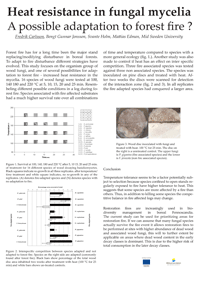 04. Increased heat resistance found in mycelia from wood fungi
prevalent on fire-affected substrates: a possible adaptation to forest fire? 04. Increased heat resistance found in mycelia from wood fungi
prevalent on fire-affected substrates: a possible adaptation to forest fire?
1 Fredrik Carlsson, Department of natural science engineering and mathematics 2 Bengt Gunnar Jonsson, Department of natural science engineering and mathematics 3 Svante Holm, Department of natural science engineering and mathematics 4 Anna-Maria Eriksson, Department of natural science engineering and mathematics 5 Mattias Edman, Department of natural science engineering and mathematics
Abstract :
For a long time, forest fires have been the major stand-replacing/modifying disturbance in boreal forests. To adapt to fire disturbance, different strategies have evolved. This study focuses on wood fungi, and one of several possibilities for adaptation to forest fire: increased heat resistance in the mycelia. Sixteen species of wood fungi were selected and sorted a priori according to their prevalence on fire-affected substrates. These were isolated and re-inoculated on fresh wood before testing. Experiments were done in a series where the mycelia were exposed to 100, 140, 180, 220°C for 5, 10, 15, 20, min. A clear difference was found. The group containing species associated with fire-affected substrates had a much higher survival rate over all combinations of time and temperature compared to species with a more general ecology. Thus, these data show increased heat resistance in mycelia from species possibly adapted to forest fire. Such adaptations would have major impacts on the ecology and population dynamics of wood fungi, as well as implications for best practices in prescribed restoration burning events. Download poster :  |
 05. Effects of removing logging residues as a source of bioenergy on soil conditions and tree growth 05. Effects of removing logging residues as a source of bioenergy on soil conditions and tree growth
1 Amélie Trottier-Picard, UQAT - Chaire AFD & CEF 2 Annie Desrochers, UQAT - Chaire AFD & CEF 3 David Paré, NRCan, Canadian Forest Service 4 Evelyne Thiffault, NRCan, Canadian Forest Service 5 Nelson Thiffault, Quebec Ministry of Natural resources and Wildlife 6 Christian Messier, UQAM - Chaire AFD & CEF
Abstract :
In Quebec, intensive harvesting of forest biomass represents one of the most promising sources of bioenergy. However, removal of logging residues could affect soil productivity and stand regeneration depending on site sensitivity and physiological characteristics of the regenerating species. Following harvesting, three species were planted in each of four sites across the province of Quebec. Species range from the fast-growing hybrid poplar to the less nutrient-demanding black spruce, and sites represent a gradient of climatic and edaphic conditions. Each species was exposed to eight treatments contrasting the influence of the removal of logging residues on microclimate, vegetative competition, and soil nutrients. The corresponding physiological responses of planted trees regarding tree nutrition, water stress, and growth, will be compared between species and sites. The goal is to work towards the development of guidelines for the quantity of logging residues that can be harvested depending on species and site, without affecting soil fertility and growth potential. Download poster :  |
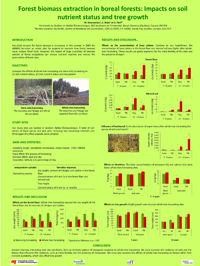 06. Forest biomass extraction in boreal forests: Impacts on soil nutrient status and tree growth 06. Forest biomass extraction in boreal forests: Impacts on soil nutrient status and tree growth
1 M' Bark Oumouhou, UQAT - Chaire AFD & CEF 2 Suzanne Brais, UQAT - Chaire AFD & CEF
Abstract :
Increased harvesting of forest biomass may reduce site nutrient reserves and tree growth. Our study was conducted in the boreal forest of northwestern Quebec and investigated soil nutrient status and growth and nutrition of forest regeneration following stem-only (SO) and whole tree harvesting (WTH) on sites of contrasting fertility. The study area covered three types of surfacial deposits (glaciolacustrine clays, tills and fluvioglacial sands) and three species (black spruce, jack pine and aspen). Soil sampling, growth measurements and leaf collection were performed on 117 sites that were harvested 7 to 14 years prior to the study. Whole-tree harvesting reduced forest floor dry weight and N content compared to SO harvesting. Contrary to our hypothesis, forest floor and mineral soil base cation concentrations were higher following WTH. This result may be partly explained by the abundant regeneration of trembling aspen on WTH sites as aspen leaf litter is known to increase upper soil nutrient content. Compositional nutrient diagnostic (CND) ratios, computed using foliar concentrations, were negatively affected by WTH on clay and sand sites but not on tills. However, growth of jack pine and black spruce was reduced by WTH on till sites. Because regional till is coarse-textured and generally located on upper slopes where its depth is limited, WTH could make these difficult growing conditions worse. Harvesting intensity interacts with soil fertility, vegetation and site conditions to create complex patterns of ecosystem response to whole-tree harvesting. Download poster :  |
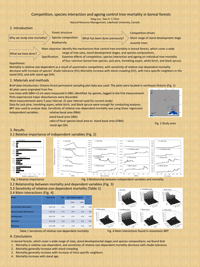 07. Competition, species interaction and aging control tree mortality in boreal forests 07. Competition, species interaction and aging control tree mortality in boreal forests
1 Yong Luo, Lakehead University 2 Han Chen, Lakehead University
Abstract :
Tree mortality is one of the central foci in forest ecology as tree mortality alters forest structure and composition. Metabolic ecology theory is proposed to predict tree mortality in equilibrium in tropical forests. In un-equilibrium forests, previous studies have focused on the influence of resource competition on the mortality of juvenile trees, or at one stage of stand development. Using long-term permanent sampling plots data that covered a wide range of tree sizes and stand conditions, we examined the effects of competition, species interaction, and aging on individual tree mortality in un-equilibrium boreal forests. We used boosted regression tree models to partition the influence of relative basal area, stand basal area, the ratio of focal species to stand basal area, and stand age on mortality for four common boreal species. We found that relative basal area had the strongest influence on mortality, and sensitivity of size-dependent mortality decreased from shade-intolerant to shade-tolerant species. With increasing stand basal area, mortality increased for Pinus banksiana, Populus tremuloides, and Picea mariana, but decreased for Betula papyrifera. Mortality increased with increase of intra-specific neighbours in the stands for Populus tremuloides, Betula papyrifera and Picea mariana, but decreased for Pinus banksiana. Mortality also increased with stand age for all species. Our results show in un-equilibrium boreal forests, tree mortality is driven by resource competition, species interactions, and species longevity, and influences of these mechanisms differ with species' shade tolerance trait. Download poster :  |
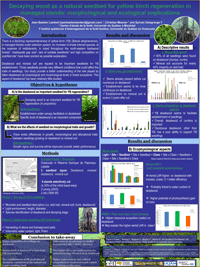 08. Plasticity in growth, biomass partitioning and root architecture of yellow birch seedlings growing on decaying wood: ecological implications 08. Plasticity in growth, biomass partitioning and root architecture of yellow birch seedlings growing on decaying wood: ecological implications
1 Jean-Bastien Lambert, UQAM - CEF 2 Christian Messier, UQAM & CEF 3 Sylvain Delagrange, UQO & CEF & IQAFF
Abstract :
Decaying wood is a well-known microsite for the germination and establishment of small seeded trees such as yellow birch. In managed temperate deciduous forests of north-eastern America, where decaying wood is rare, forest managers routinely use scarification to expose some mineral soil to facilitate yellow birch regeneration. However, many casual observations made over the years suggest that yellow birch do not do as well on mineral soil as on decaying wood. The possible causes are not known, but we hypothesised that many root traits important for yellow birch growth and survival are improved in decaying wood compared to mineral soil, which would then improve their efficiency for gap filling. To verify our main hypothesis, we sampled seedlings growing on three different types of seedbeds (mineral soil, decaying wood and decaying wood colonised by mosses). We destructively sampled 90 seedlings for each seedbed on 6 and 14 year-old selection cuts. We measured many traits associated with growth, biomass partitioning, root architecture and survivorship of the seedlings. Our preliminary results indicate that decaying wood provides better growing conditions than mineral soil for many of the traits that we measured, and that these conditions were not associated with better light environment. Consequently, we emphasize that (i) decaying wood is playing a key role in the natural regeneration processes of the mid-shade tolerant tree species yellow birch and that (ii) this role should be integrated in the silvicultural and management practices of this species. Download poster :  |
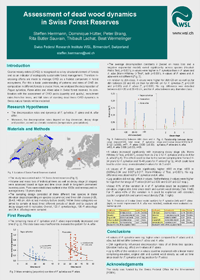 10. Assessment and modelling of dead wood dynamics in Swiss Nature Forest Reserves 10. Assessment and modelling of dead wood dynamics in Swiss Nature Forest Reserves
1 Steffen Herrmann, Swiss Federal Research Institute WSL 2 Dominique Hütter, 3 Peter Brang, Birmensdorf 4 Rita Bütler Sauvain, 5 Thibault Lachat, 6 Beat Wermelinger,
Abstract :
Coarse woody debris (CWD) is now recognized as a key structural element of forests and as an indicator of ecologically sustainable forest management. It is particularly important for biodiversity and carbon balance, especially sequestration. Currently increasing efforts are made to manage CWD as a habitat component and a carbon store in Swiss (and European) forest ecosystems. For this a basic understanding of patterns and rates of dead wood decomposition in different forests is crucial. The decomposition rate of CWD is mainly dependent on climatic (wood temperature, wood moisture) and substrate specific (tree species, decay stage, diameter) variables. Here, we analysed the influence of these factors and assessed the decomposition rate of Fagus sylvatica, Picea abies and Abies alba in three diameter classes (10-20 cm, 20-40 cm, >40 cm) along a climatic/altitudinal gradient (temperature, precipitation) and with a constructed chronosequence based on the different decay stages (and –ages) in Swiss nature forest reserves. Volume and mass loss of individual trees as well as decay stage (in 4 decay classes) were assessed based on type and year of origin in long-term permanent inventory plots. Earliest plots were established in the 1960s and were remeasured on average every 10 years since. In combination with the assessment of CWD pools (quantity and quality), recruitment rates from live trees, and fall rates of standing dead trees CWD dynamics in Swiss natural forests could be modelled. Download poster :  |
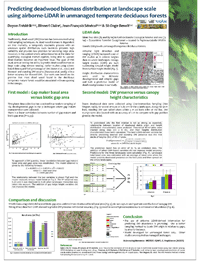 11. Predicting dead wood volume at landscape scales using airborne-LiDAR delineated gaps in an unmanaged old growth temperate deciduous forest 11. Predicting dead wood volume at landscape scales using airborne-LiDAR delineated gaps in an unmanaged old growth temperate deciduous forest
1 Frédérik Doyon, UQO - IQAFF & CEF 2 Claire Binnert, Département des sciences sociales, UQO 3 Jean-François Sénécal, Secteur Foresterie 4 Benoit St-Onge, UQAM - CEF
Abstract :
Traditionally, dead wood volume has been assessed using field sampling techniques. These inventories present high variability and provide low precision for assessing large areas. When quantifying carbon becomes a stake for ecological market equities, being able to upscale dead volume becomes an important issue. This study aims at testing the ability to predict dead wood volume at large scale using remote sensing. We tested the assumption that most dead wood found in the deciduous temperate mature forest would be associated with an opening in the canopy using a map of 164 gaps delineated from a Canopy Height Model (CHM) derived from airborne LiDAR data collected over three unmanaged old-growth temperate deciduous forest landscapes (1 km2) in Outaouais, Québec. We then put into the relationship gap characteristics (size and ledge height) and the basal area and the number of dead wood pieces (snag and coarse woody debris (CWD)) in the gap and its surroundings (4 m). Our results show that dead wood pieces are not randomly distributed but closer to LiDAR-detected gaps; this relationship improves as the dead wood piece size increases. We successfully developed a relationship (P<0.001) to predict dead wood as a function of gap size, although the relationship was not as strong as expected (basal area: R2=0.30 and number of pieces: R2=0.37). Gap ledge height did not improve the model neither did predicting the mean size of the dead wood pieces. Combined with field sampling, our model may provide a promising solution for large scale dead wood volume inventory. Download poster :  |
 12. Deadwood in close to old-growth forest stands under Mediterranean conditions in the Italian peninsula 12. Deadwood in close to old-growth forest stands under Mediterranean conditions in the Italian peninsula
1 Fabio Lombardi, Università degli Studi del Molise 2 Gherardo Chirici, Università degli Studi del Molise 3 Marco Marchetti, Università degli Studi del Molise 4 Roberto Tognetti, Università degli Studi del Molise 5 Bruno Lasserre, Università degli Studi del Molise 6 Piermaria Corona, Università degli Studi della Tuscia 7 Anna Barbati, Università degli Studi della Tuscia 8 Barbara Ferrari, Università degli Studi della Tuscia 9 Silvia Di Paolo, Università degli Studi della Tuscia 10 Diego Giuliarelli, Università degli Studi della Tuscia 11 Franco Mason, Centro Nazionale per lo Studio e la Conservazione della Biodiversità Forestale "Bosco della Fontana"- CFS 12 Francesco Iovino, Dipartimento di Difesa del Suolo Vincenzo Marone, Università della Calabria 13 Antonino Nicolaci, Dipartimento di Difesa del Suolo Vincenzo Marone, Università della Calabria 14 Livio Bianchi, Università Degli Studi Di Firenze 15 Alberto Maltoni, Università Degli Studi Di Firenze 16 Davide Travaglini, Università Degli Studi Di Firenze
Abstract :
This study provides some results to identify the distinctive traits of old-growth forests in the Mediterranean ecoregion. Deadwood occurrence is investigated in some forest areas that have developed in absence of anthropogenic disturbance over the past decades. Eleven study sites across the Italian peninsula were selected and records of deadwood were carried out in 1-ha size plots. Deadwood volume, types and decay stages were inventoried. The amounts of deadwood indicate a large variability among the investigated forests: the total volume ranged between 2 and 143 m3ha-1, with an average of 60 m3ha-1. Lying deadwood is the most abundant component, due to the natural mortality occurring in the stands in relation to the processes established in the last decades. On the contrary, stumps are the less represented type of deadwood in almost all the study areas. All the decay classes are present in each study site. The amount of deadwood in Southern Europe, even if lower than that reported for North and Central European countries, could have a different meaning due to the faster decay rate occurring in Mediterranean forest ecosystems. For this reason, old-growth features and the characteristics of each indicator should be framed and referred to well-defined climatic and biogeographic contexts. Under the conditions here investigated, three main deadwood features characterize forest stands close to old-growth: a ratio of dead to living wood not lower than 10%; lying deadwood much more abundant than the standing one; large range of deadwood size and decay classes across all the deadwood components. Download poster :  |
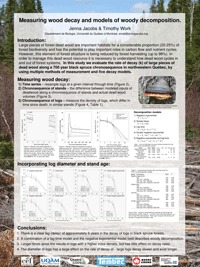 13. Measuring wood decay and models of woody decomposition. 13. Measuring wood decay and models of woody decomposition.
1 Jenna Jacobs, UQAM - Chaire AFD & CEF 2 Timothy T. Work, UQAM - Chaire AFD & CEF
Abstract :
Numerous methods are employed for measuring wood decay and several models have been proposed
to generalize woody decomposition. The most obvious method of measuring wood decay is a
time series that follows pieces of wood through the decomposition process. Others have
used a log chronosequence approach finding logs of different ages in similar stands and
infer decomposition rates. Decomposition rates can also be estimated using a chronosequence
of stands of different ages and can be combined with the time-series approach, known as the
decomposition-vector method, to estimate decomposition rates. With all these approaches it
becomes important to use a model that properly reflects both the data and the process of
woody decomposition. The negative exponential model is the most common model, however
several other models exist that have received less attention, including lag time models,
double exponential models and polynomial models. Here we combine common methods of
measuring decomposition in black spruce dominated forests with a 10 year time series across
a 700 year chronosequence and resample two years apart. We then compared decomposition
models and discuss the relative implications. Preliminary results suggest that a lag time
model with a two year lag best fits the data. The implication of this model is that decay
rates are actually much higher than what is found using the standard negative exponential
model. Download poster :  |
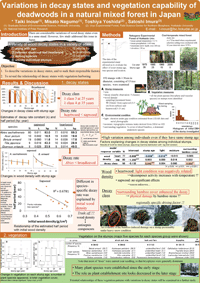 14. Variations in decay states and vegetation capability of deadwoods in a natural mixed forest in Japan. 14. Variations in decay states and vegetation capability of deadwoods in a natural mixed forest in Japan.
1 Taiki Inoue, Graduate School of Environmental Science 2 Misato Nagumo, Hokkaido University 3 Toshiya Yoshida, Graduate School of Environmental Science, Kyoto University
Abstract :
We investigated decay states and vegetation capability of dead woods in natural mixed forests in northern Japan. We surveyed 192 cut-stumps, consisting of 13 tree species (mainly Abies sachalinensis, Quercus crispula, Acer mono, Betula ermanii), recorded in a selection-cut stand established in 1970. To evaluate decay states of these stumps, we measured visual decay class (5 classes) and surface hardness. In addition, we determined water contents, wood density and CN contents of the sampled cores. The vegetation established on the stumps were also recorded. The mean decay class of the stumps supplied 5 and 35 years ago was respectively 1.20 (0.53, SD) and 4.57 (0.54). However, decay states were highly variable among stumps. In terms of wood density, some species showed no clear decline trend across the years; when species were taking together, the sapwood density of 5-year-old and 35-year-old stumps was 0.35 (0.10) and 0.34 (0.07) g/cm3, respectively. Regarding vegetation, 37 % of the stumps harbored canopy-species seedlings, 75 % of which (177 seedlings) were B. ermanii. The vegetation cover was highest on decay class 3 (43 % (27)), but there was again considerable variation among stumps. Results examining the effect of stump species and surrounding environmental conditions on the variations found both in decay states and established vegetation will also be presented. Download poster :  |
 15. A test for rapid assessment of saproxylic beetle biodiversity using subsets of “monitoring species” 15. A test for rapid assessment of saproxylic beetle biodiversity using subsets of “monitoring species”
1 Pavel Sebek, Institute for Engineering in Agriculture and Environment (Cemagref) 2 Christophe Bouget, Institute for Engineering in Agriculture and Environment, Cemagref 3 Hervé Brustel, Department of Botany and Zoology, Masaryk University 4 Antoine Brin, Department of Botany and Zoology, Masaryk University 5 Marc Dufrêne, Centre de Recherche de la Nature, des Forêts et du Bois, Ministère de la
Région wallonne 6 Thierry Noblecourt, Réseau Naturaliste « Entomologie », Office National des Forêts 7 Thomas Barnouin, Réseau Naturaliste « Entomologie », Office National des Forêts 8 Lilian Micas, Réseau Naturaliste « Entomologie », Office National des Forêts 9 Olivier Rose, Réseau Naturaliste « Entomologie », Office National des Forêts 10 Laurent Velle, Réseau Naturaliste « Entomologie », Office National des Forêts 11 Bruno Meriguet, Office Pour les Insectes et leur Environnement
Abstract :
Saproxylic beetles have been frequently proposed to evaluate the conservation status of temperate forest. Due to their high species richness and the lack of comprehensive literature in Europe, many beetle species can only be determined by a few experts, which makes biodiversity surveys expensive and time consuming. Therefore, there is a need to develop simple and reliable rapid-assessment techniques for biodiversity surveys to be cost-effective. Our study aimed at assessing the potential for different subsets of taxa to serve as surrogates for biodiversity assessment, and as indicators for biodiversity monitoring. Could large-scale diversity studies be financially restricted to a subset of species that mirror the diversity pattern of the entire community? We built a large scale compiled dataset (ca 80 elementary datasets, 650 plots, 1400 traps, 1000 beetle species) from biodiversity surveys or ecological studies in France and in Belgium, covering a wide range of environmental conditions (latitude, altitude, forest type…). We figured out the number of species in different predefined subsets of pragmatic species (easy-to-identify species, monitoring species defined by crossing ecological requirements, rarity and “identifiability”, red-listed species, individual families and their combinations, faunal subsets derived by aggregating the beetle fauna at higher taxonomic levels (number of genera, number of families)). Over our large forest and geographical gradient, and three nested spatial scales, we analyzed the performance of surrogates using the correlation between the number of species in subsets and in the global assemblage. Download poster :  |
 16. Host compatibility of eastern Canadian bark- and wood-boring insects for three European trees: Norway maple, Norway spruce, and Scots pine 16. Host compatibility of eastern Canadian bark- and wood-boring insects for three European trees: Norway maple, Norway spruce, and Scots pine
1 Martin Payette, FQRNT 2 Timothy T. Work, UQAM - Chaire AFD & CEF
Abstract :
The international exchange of goods and materials is a major contributor to the introduction of invasive species. Wood packing materials, such as wood pallets, are important vectors for many bark- and wood-boring insect larvae. Notable examples of invasive insects possibly introduced through pallets are the Asian longhorn beetle and the Emerald ash borer. Once they are established and become invasive, these insects can decimate tree populations in plantations and in urban or natural areas. Before an exotic insect can establish a population, however, it must find a suitable host tree to complete its life-cycle. Many papers study the compatibility of already invasive insects with tree species in their new ranges. The current study will test a more pre-emptive approach. Our aim is to (1) create a preliminary (if incomplete) list of Nearctic xylophages from eastern Canada that could potentially establish themselves in European trees and to (2) find common life-traits among these species that could help predict what other North American species have that same potential. Most xylophagous insects are attracted to weak, dying or dead trees. Cut logs from sugar maple, black and white spruce, and jack pine will be placed in stands dominated by their respective species alongside Norway maple, Norway spruce, and Scots pine for periods of approximately two months. We will then compare species richness and abundance in both the North American and European logs. Preliminary results will be available by spring 2011 and at the conference. Download poster :  |
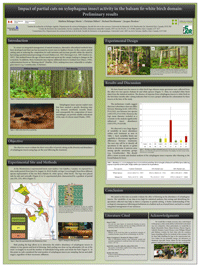 17. Impact of partial cuts on xylophagous insect activity in the balsam fir-white birch domain 17. Impact of partial cuts on xylophagous insect activity in the balsam fir-white birch domain
1 Mathieu Bélanger Morin, Université de Montréal 2 Jacques Brodeur, Institut de Recherche en Biologie Végétale 3 Christian Hébert, RNCan 4 Richard Berthiaume, Consortium iFor
Abstract :
To ensure an integrated management of natural resources, alternative silvicultural methods have been developed and their use has increased in recent years in Québec’s forests. In this context, partial cutting aims at harvesting a predetermined percentage of wood. This method lowers the age of forest stands and opens up the canopy, leading to changes in the ecosystem. In addition, these treatments may impose additional stress to residual trees, a phenomenon known as “thinning shock”, making trees more vulnerable to xylophagous insects (e.g. Cerambycidae, Scolytinae). The objective of this project is to quantify the abundance and evaluate attack rates of xylophagous insects on residual trees the year following a partial cut using recently cut logs. At the Montmorency experimental forest, near Québec City (Québec, Canada), we exposed freshly cut logs (2m in length) from three different species representative of the tree flora (balsam fir, white spruce, paper birch). The logs were placed in experimental plots characterized by a gradient of partial cuts (i.e. 0%, 25%, 40%). Xylophagous insect species specialized in trees that have reached a specific decaying state (e.g. stressed, moribund, recently dead), and consequently the composition of insect assemblages can provide reliable indications of the state of the forest stand. Bark peeling the logs allows us to determine the relative abundance and attack rates of xylophagous insects in relation to tree species and level of thinning. Preliminary results will be discussed. Download poster :  |
18. Impact of salvage logging on saproxylic beetles living in black spruce stumps: response of cerambycids 1 Olivier Jeffrey, Laval University & CEF 2 Éric Bauce, Laval University & CEF 3 Jacques Ibarzabal, UQAC & CEF 4 Christian Hébert, RNCan
Abstract :
Boreal forest occupies 72% of the Quebec forest territory and the exploitation of the wood represents an important economic activity. Natural disturbances such as forest fires threaten this economy, even if contributing to renewal of the ecosystems. To maintain constant wood supplies, the forest industry salvages more burned trees than ever before. The objective of this project is to characterize the ecological value of burned woody matter left after salvage, such as stumps, residual snags and down dead wood, for saproxylics beetles through time along a chronosequence of 15 years postfire. 120 trunk window traps, as a device to trap beetles, were installed in burns that prevailed in 1995, 2003, 2005, 2007, 2009 and 2010. Salvage operations were conducted in all studied burns, except those of 2009 and 2010. Sampling was done during the summer of 2010, from which more than 1 000 cerambycids were identified and distributed in 19 species. Our results show lower abundance of cerambycids in the salvaged sites from recent fires (2007) when compared to residual sites. However, no difference was observed in other postfire years. The uniformity of the environmental variables could explain parts of these results. Thus, further analyses are needed to assess the main variables affecting cerambycid distribution in postfire habitat. Download poster : available soon |
19. Spatial segregation of three longhorned beetles in burned trees of the boreal forest
1 Yannick Cadorette-Breton, Consortium iFor 2 Christian Hébert, RNCan 3 Richard Berthiaume, Consortium iFor 4 Jacques Ibarzabal, UQAC & CEF 5 Éric Bauce, Laval University, Consortium iFor
Abstract :
In a context of timber’s scarcity, post-fire salvage logging is increasingly used to maintain wood volumes needed to support industrial activities. However, if salvage logging is delayed, damage caused by woodborers in recently burned stems may cause considerable economic losses. In this study, we examined the spatial segregation of three major Cerambycid species, Monochamus scuetellatus scutellatus Say (whitespotted sawyer), Acmaeops proteus proteus Kirby and Arhopalus foveicollis Haldeman, in jack pine and black spruce trees across different burn severity (low, moderate & high) in three 2009 burns of northern boreal forest. Four trees with a diameter at breast height ranging between 15 and 20 cm were cut for each treatment (tree species × burn severity) and 30cm logs were collected at different heights along the stem of each tree. Overall, 504 logs were collected and brought to the laboratory where they have been debarked and larvae collected. Result shows that A. foveicollis is only present in the lowest log and mainly in lightly burned jack pine, while A. p. proteus is found all along the stem in all treatments. The abundance of M. s. scutellatus is higher on black spruce and on lightly burned trees. Its abundance decreases from the stump towards the top on spruce while it remains rather constant on pine trees. These estimates of longhorned beetle densities will help to improve salvage logging by directing operations where damages are lower. Download poster : available soon |
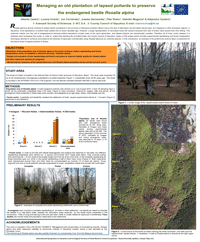 20. Managing an old plantation of lapsed pollard trees to preserve the endangered beetle Rosalia alpina (Insecta: Coleoptera) 20. Managing an old plantation of lapsed pollard trees to preserve the endangered beetle Rosalia alpina (Insecta: Coleoptera)
1 Juan Alberto Castro, Society of Sciences of Aranzadi 2 Lorena Uriarte, Society of Sciences of Aranzadi 3 Jon Fernández, Society of Sciences of Aranzadi 4 Joseba Garmendia, Society of Sciences of Aranzadi
Abstract :
Several saproxylic species are endangered because big mature trees have become scarce in most temperate forests as a consequence of traditional timber exploitation. This fact is exemplified by Rosalia alpina in the province of Gipuzkoa (Northern Spain), where in absence of alternative natural old big beechs, the species is almost confined to pollard beech woodlands, as occurs in other European regions. In Gipuzkoa, exploitation of pollard trees ceased five to seven decades ago. A large representation of old pollard trees still remains because their lack of timber value saved them from felling. This particular habitat runs the risk of dissapearing because pollard plantations contain trees mostly of the same generation, and lapsed pollards are mechanically unstable. Therefore all of them could collapse in a relatively short ecological time scale. To check what kind of pruning will extend the life of trees, three different re-pollarding techniques have been planned in 3 ha of the gipuzkoano woodland of Artaso. The population of Rosalia alpina has been censused in the summer. Both, pollard trees´and Rosalia alpina´s response, will be monitored. To date, 90 trees have been re-pollarded following two different techniques, and 31 individuals of Rosalia alpina have been registered. As more experimental strategies will be applied in the future, the plan described in this contribution is open to discussion with the assistants of the symposium to improve it next years. Download poster :  |
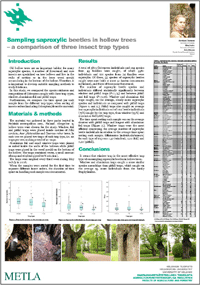 21. Comparison of three insect trap types to survey saproxylic beetles in hollow trees 21. Comparison of three insect trap types to survey saproxylic beetles in hollow trees
1 Elina Peuhu, University of Helsinki 2 Pia-Maria Thomssen, Department of Forest Sciences 3 Juha Siitonen, Finnish Forest Research Institute, University of Helsinki
Abstract :
Old hollow trees are an important habitat for many saproxylic species. Many endangered and rare insects are specialized on tree hollows and live in the walls of the hollow or in wood mold in the bottom of the hollow. Therefore, it is important to develop suitable sampling methods to study this fauna more precisely.
In this study, we compare the species richness and assemblage structure of Coleoptera caught with three trap types in hollow trees. Window, aluminum foil and pitfall traps were placed inside hollow linden, maple, oak and elm trees. Altogether 15 live standing hollow trees were chosen for the study. Insects were sampled from June to September in 2006 in five urban parks located in Helsinki metropolitan area, Finland.
A total of 1011 Coleoptera individuals and 117 species are identified so far, of which 867 individuals and 78 species were saproxylic. Species assemblages caught with window and aluminum foil traps were more similar to each other than with pitfall traps, which caught more species living in wood mold. Pitfall traps also caught on average less saproxylic individuals out of total beetle individuals (57%) than window (90%) and aluminum foil (95%) traps.
Used trap type affected the Coleoptera species assemblage caught in hollow trees. It is important to choose the appropriate trap type for studies, and to use more than one trap type to ensure detecting as many of the species present as possible. Download poster :  |
22. Insights about saproxylic biodiversity living in old-growth forests of the French Pyrenees1 Jean-Marie Savoie, University of Toulouse 2 Hervé Brustel, EI Purpan 3 Lionel Valladares, University of Toulouse 4 Laurent Larrieu, EI Purpan 5 Gilles Corriol, University of Toulouse 6 Carole Hannoire, EI Purpan 7 Clother Coste, INRA Dynafor 8 Véronique Sarthou, Conservatoire Botanique National des Pyrénées et de Midi-Pyrénées 9 Antoine Brin, Conservatoire Botanique National des Pyrénées et de Midi-Pyrénées
Abstract :
To preserve saproxylic species, forest managers need deadwood standards. Ancient forests may provide relevant data about deadwood and associated species assemblages as they haven’t undergone any human intervention for several decades. The aim of our study was i) to improve our knowledge of saproxylic biodiversity in ancient forests and ii) to explore the co-variation of species richness and assemblage composition of several saproxylic groups and their relationships with deadwood attributes.
We sampled Fungi, Beetles, Syrphids and Bryophytes during two years (2008 and 2009) in 10 old-growth forests in the French Pyrenees : 2 beech forests, 4 mixed beech-fir forests , 3 fir forests and 1 pine forest. Cortical Lichens and vascular plants have been inventoried as they are considered to be good indicators of ancient forests. Stand characteristics and deadwood attributes have also been assessed.
Despite the gradient of deadwood volume (from 20 to 230 m3/ha), no significant effect of this variable has been observed on species richness or on composition of saproxylic assemblages. By contrast, the quality of deadwood (i.e. diversity of types of deadwood) had a significant effect on composition of beetle and syrphid assemblages. Furthermore, no pattern of co-variation among taxa has been observed. Those preliminary results i) confirm the importance of deadwood quality for the conservation of saproxylic species and ii) suggest that multi-taxonomic approach are necessary if we want to established deadwood standards.
Download poster : available soon |
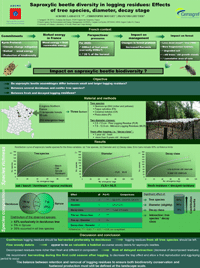 23. Saproxylic beetles in harvesting residues in temperate forests – effects of tree species, diameter, decay class and felling type. 23. Saproxylic beetles in harvesting residues in temperate forests – effects of tree species, diameter, decay class and felling type.
1 Aurore Lassauce, ADEME - Cemagref 2 Christophe Bouget, Cemagref 3 François Lieutier, University Orléans
Abstract :
Converting fossil-based energy systems into carbon-neutral systems is an essential strategy to reach targets set by the Kyoto Protocol. For nations with a forestry industry, bioenergy based on logging residues or slash harvesting has a huge potential for development.
However, forest fuel harvesting may have ecological consequences, notably for saproxylic biodiversity. Indeed, it reduces the volume of deadwood and is likely to alter the deadwood profile. However the consequences of such harvesting on biotic assemblages in temperate forests remains poorly documented. We compared the species richness and composition of saproxylic beetle assemblages among different types of logging residues. We asked if logging residues have a beetle fauna of conservation interest. Samples of logging residues were collected in 60 cutting areas, located in 12 forests from northern and south-eastern France. Our sampling design crossed four main factors describing deadwood type or environmental conditions: tree species (Quercus sp, Fagus sp, Carpinus sp, Picea abies), diameter class (5cm, 10 cm), age class (1 year after logging, more than 5 years after logging) and stand conditions. Four felling types were studied: young improvement cutting, mature improvement cutting, regeneration cut and coppice cutting.
On the basis of previous boreal results, we hypothesized that tree species and diameter are the most important variables structuring saproxylic biodiversity.
Our results will lead us to discuss the role of slash retention in maintaining the saproxylic biodiversity in temperate forests.
Download poster :  |
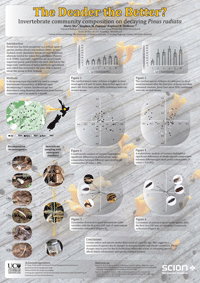 24. Landscape driven effects of saproxylic invertebrates on wood decomposition in a New Zealand production forest 24. Landscape driven effects of saproxylic invertebrates on wood decomposition in a New Zealand production forest
1 Alwin Sky, School of Biological Sciences 2 Raphael Didham, University of Canterbury 3 Stephen Pawson, School of Animal Biology, Scion
Abstract :
Saproxylic invertebrates are dependent on dead wood to complete their life-cycle. This dependency is either direct, as a feeding resource, or indirect as a source of habitat or food. They play key roles in important ecosystem processes such as decomposition and nutrient cycling. We are assessing how landscape context, proportion of native habitat in the surrounding landscape and edge gradients influence saproxylic beetle communities and subsequent decomposition of Pinus radiata. We combined two different sampling methodologies across nine replicated habitat gradients from native forest fragments into the adjacent plantation forest: 1) P. radiata log billets as passive traps for saproxylic invertebrates to measure decomposition, and 2) flight intercept trapping. A second component of the study was to assess host specificity and colonisation preferences of saproxylic invertebrates. Timber billets of three native tree species (Schefflera digitata, Melicytus ramiflorus and Aristotelia serrata) were placed alongside selected P. radiata billets. The edge response associated with native timber resources will be compared to determine if there is any interaction between edge gradient effects and colonisation preferences. For example, host specificity towards native timber, may result in some species only being found living in, and close to, native fragments, not in pine forest. A third component of the study is to determine how saproxylic invertebrate communities change with the age of the timber resource. To do this we used a chronosequence approach and collected P. radiata timber of a known age in the forest and sampled invertebrate community composition using emergence chambers. Download poster :  |
 25. Stages of White Spruce Log Decomposition and Saproxylic Beetle Diversity 25. Stages of White Spruce Log Decomposition and Saproxylic Beetle Diversity
1 Seung-Il Lee, University of Alberta 2 John R. Spence, Alberta School of Forest Science and Management, University of Alberta 3 David W. Langor, NRCan
Abstract :
Increasing attention is being paid to deadwood because it is an important ecological resource providing unique structural characteristics that are critical habitats for various organisms. Many studies have proved how forestry practices such as clear-cutting and salvage logging negatively affect saproxylic organisms (i.e., organisms that depend on dead or dying wood during some part of their life cycle). Nevertheless, there is little specific information about hyper-diverse saproxylic organisms in North America, especially beetles that relates to changes in community composition to different stages of deadwood decomposition. Such information is crucial for conserving biodiversity in the context of sustainable forest management because many different species including rare and threatened species occur throughout the range of decomposition stages. During 2009-2010, a total of fifty four white spruce logs ranging from decay class 1 to 6 were cut to provide bolts c. 60 cm in length and moved to rearing cages and held in forest near the EMEND camp in NW Alberta. Saproxylic beetles were sampled six times during the summer to provide specific information about the assemblages using white spruce downed deadwood ranging over a ‘successional’ sequence from freshly dead to well decayed. Download poster :  |
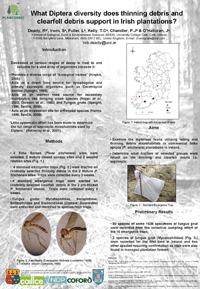 26. Diptera diversity associated with debris resulting from thinning and clearfell activity in commercial Sitka spruce plantations in Ireland paying particular attention to the Mycetophilidae, Keroplatidae, Bolitophilidae and Diadocidiidae (Diptera: Sciaroide 26. Diptera diversity associated with debris resulting from thinning and clearfell activity in commercial Sitka spruce plantations in Ireland paying particular attention to the Mycetophilidae, Keroplatidae, Bolitophilidae and Diadocidiidae (Diptera: Sciaroide
1 Rob Jon Deady, University College Cork 2 Tom Kelly, University College Cork 3 Peter Chandler, 4 Lauren Fuller, University College Cork 5 Sandra Irwin, University College Cork 6 John O' Halloran, University College Cork
Abstract :
Destruction of global ecosystem functioning, biodiversity and ecosystem services is occurring at an alarming rate. This damage is most evident in highly speciose ecosystems that are typically the focus of conservation concern. Forests, in particular, house a suite of species due to the heterogeneity of their composition in terms of, habitat, microclimates and resource availability. In managed forests, habitat heterogeneity is often reduced due to successional felling. A current trend of deadwood extraction for use as biofuel is further pressuring these ecosystems, and specifically at risk are saproxylic arthropods due to their reliance on it.
This study aimed to examine the dipterous fauna utilizing felling and thinning debris in commercial Sitka spruce plantations in Ireland. This habitat is particularly important in preserving species that may be lost due to forestry management operations. Using Standard Emergence Traps (S.E.Ts), we compared woody debris resulting from clearfell processes to debris from systematic thinning of stands. We examined the abundance and species richness of Mycetophilidae, Keroplatidae, Bolitophilidae and Diadocidiidae (Diptera: Sciaroidea) to test the null hypothesis that there is no difference between clearfell and thinning debris. We also investigated whether the assemblages in the debris consisted mainly of saproxylic species.
Preliminary results suggest that there is a sustained fungus gnat population in thinning debris, probably feeding on the ascomycetes breaking down the woody debris. Approximately 80 species have been catalogued with potentially 5 new species to Ireland.
Download poster :  |
 27. Downed deadwood: Nurse logs for whom in the eastern boreal mixedwood? 27. Downed deadwood: Nurse logs for whom in the eastern boreal mixedwood?
1 Émilie Robert, UQAT - Chaire AFD & CEF 2 Suzanne Brais, UQAT - Chaire AFD & CEF 3 Brian Harvey, UQAT - Chaire AFD & CEF
Abstract :
Coarse woody debris (CWD) has been recognized as a favourable substrate for germination and growth of regeneration in many forest ecosystems, a quality that has earned it the term "nurse logs". CWD presence can therefore influence forest composition and dynamics. In this study, we took advantage of a mast year in 2006 to compare the establishment and survival of seedlings of five tree species on downed logs and on the forest floor in the eastern boreal mixedwood forest. Seedling surveys were conducted in the fall 2007 and the spring and fall of 2008 in three stand types representing different successional stages: aspen; mixed aspen-fir-spruce; and post-spruce budworm fir-spruce-cedar-birch. Each log was paired with an adjacent equivalent area of forest floor. The following characteristics were measured on each log: decomposition stage, hardness, density, moisture and C:N ratio. Other characteristics measured on logs and on the forest floor included percentage of herbaceous, litter, and moss cover, and thickness of moss and leaves. Data were analyzed using logistic regressions. Probability of seedling establishment increased with wood moisture content and decreased with hardness (of logs), whereas probability of survival decreased with hardwood basal area in stands. Our results show that species that produce small seeds, such as white birch and spruce, established preferentially on dead wood, while fir established more frequently on the forest floor. Relatively open stands with high volumes of downed wood provide best conditions for seedling establishment of spruce and birch. Download poster :  |
 28. Monitoring French forest reserves to better understand deadwood dynamics 28. Monitoring French forest reserves to better understand deadwood dynamics
1 Nicolas Debaive, Réserves Naturelles de France / Office National des Forêts 2 Nicolas Drapier, Office National des Forêts 3 Olivier Gilg, Réserves Naturelles de France 4 Loïc Duchamp, Sycoparc 5 Max Bruciamacchie, Agroparistech – ENGREF
Abstract :
Although the importance of deadwood for the conservation of forest dwelling species is now well-established by scientists and increasingly acknowledged by policy makers, the natural dynamics of deadwood in temperate Western European forests remains poorly known. To fill this gap, a long-term monitoring scheme has been implemented in the French forest reserves (National Nature Reserves and Strict Biological Reserves). By precisely monitoring (on average on a 10-year time scale) the flows of living biomass and deadwood, this protocol provides information on the distribution, origin, and ultimately (after the second and later measurements) on the turnover and equilibrium state (at the large spatial scale of the forest mosaic for any given forest stand) of deadwood. Furthermore, the use of permanent plots enables a spatial and temporal monitoring of stand dynamics and helps us to assess the “state of conservation” of any given stand or forest. Since its launch in 2005, 67 forest reserves have been implemented, covering all main forest stands and constituting to date a database of more than 4000 permanent plots at the national scale. Download poster :  |
29. The effect of forest management intensity on the diversity of wood-decaying fungi - including the " hidden" diversity1 Tiemo Kahl, Institute of Silviculture, University of Freiburg, Germany 2 Bjoern Hoppe, University of Freiburg 3 Tobias Arnstadt, Department of Environmental Biotechnology 4 Dirk Krueger, Helmholtz Centre for Environmental Research - UFZ
Abstract :
Dead wood is decayed by various types of organisms such as insects, bacteria and fungi. Fungi, chiefly Basidiomycota and a few Ascomycota, play a dominant role. We will show the change in dead wood fungal diversity along a forest management intensity gradient. We hypothesize that the diversity of wood decaying fungi increases with decreasing forest management intensity. Our results are based on a two year study on sites of different management intensities on three different locations in Germany. The study was carried out using logs of three tree species (Fagus sylvatica, Picea abies, and Pinus sylvestris). In addition to the 2 year fungal sporocarp monitoring we also analyzed dead wood samples using molecular methods (DNA, ARISA profiles) in order to get a view on the “hidden” diversity of fungi in dead wood logs. The comparison of these methods shows an unexpectedly low number of species which are found with both methods. We discuss the reasons for these findings and implications for monitoring fungal biodiversity in dead wood logs. Download poster : available soon |
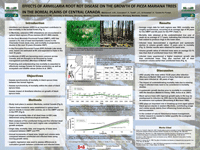 30. Susceptibility of upland black spruce trees to mortality induced by Armillaria root disease in the boreal plains of western Manitoba, Canada. 30. Susceptibility of upland black spruce trees to mortality induced by Armillaria root disease in the boreal plains of western Manitoba, Canada.
1 Alana Westwood, Centre for Forest Interdisciplinary Research (C-FIR) 2 Keith Knowles, Forestry Branch 3 Jacques Tardif, Centre for Forest Interdisciplinary Research (C-FIR), University of Winnipeg
Abstract :
Armillaria spp. are a complex of fungal root and butt-rot pathogens affecting populations of upland black spruce (Picea mariana (Mill.) B.S.P.). In Manitoba, Duck Mountain Provincial Forest (DMPF) and Porcupine Provincial Forest (PPF) contain extensive Armillaria root disease infestation. In the Clearwater Creek operating area of DMPF, mortality and growth loss due to Armillaria root disease resulted in a volume loss of 74 m3 per ha within infested areas. In 2007-2008, dead and living trees in 6 infection centres per region were sampled for growth and mortality analyses. In 2009, a subset of 10 infected dead and 10 uninfected living trees from two sites per region were selected for stem analysis. The objectives were 1) to assess whether tree mortality was synchronous among locations, and 2) to assess if Armillaria had an impact on growth by comparing live trees and those that have died. The onset of mortality in affected stands occurred quasi-synchronously across the sampling regions i.e. at an average of 96 and 99 years. Testing of incremental growth ratios indicated that infected trees experienced a sustained decline in basal area and volume increment 5-15 years prior to death, as compared to uninfected trees. Infected trees also reached half of their total height and volume at a significantly younger age than uninfected trees and it is speculated that increased vigour and larger root systems may have predisposed them for infection. Download poster :  |

